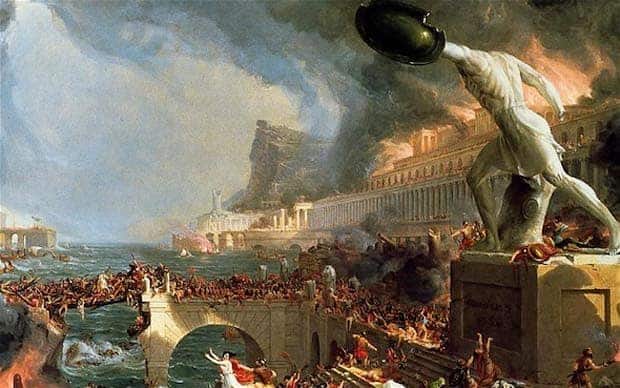There is much debate as to the causes of Rome’s destruction. What we do know is that no single factor can be blamed as it was a combination of problems that led to the demise of one of the world’s greatest empires. It reached its peak under Trajan in 117 AD but ultimately, its size caused all manner of problems. Diocletian split the empire in two at the end of the Third Century Crisis, and by then, it was swiftly heading in the wrong direction. Internal and economic factors helped weaken Rome, and the invading tribes were able to take advantage. Realistically, the empire was finished a long time before the last emperor, Romulus Augustus, was deposed in 476 AD.
German historian Alexander Demandt is an expert in the history of ancient Rome and came up with 210 different theories as to why the empire collapsed! In this piece, I will briefly look at just five possible reasons.

1 – Internal Strife
In ‘The History of Decline and Fall of the Roman Empire‘, Edward Gibbon had a controversial theory. He claimed the rise of Christianity contributed to the fall of Rome as it bred a ‘turn the other cheek’ mentality. He also claimed the religion valued idle and unproductive people and also led to internal divisions. Gibbon wrote this in the 18th century, and modern historians tend to disagree with his analysis.
Gibbon’s claim that Rome was subject to moral decay probably holds more water. In the 2nd Century BC, Polybius wrote of a decline in moral virtue that led to the fall of the Republic. The same affliction appeared to damage the empire. The original ideals, values, and traditions upon which Rome was founded declined and were replaced by a notion that life was cheap and depravity, gluttony, and cruelty were the norm.
The advent of the Gladiatorial Games is one such example. Rome developed a ‘mob’ mentality and these individuals needed to be entertained. The rise of slave labor led to a huge number of unemployed Romans who required state handouts. If they become bored, civil unrest and riots followed. The Games were a means of keeping the public in check and consisted of excessive violence and cruelty. The emperors paid for the games which of course mean the state bore the cost. At one point, setting up the Games cost one-third of the Empire’s income as rulers tried to curry favor with the people.
The breathtaking incompetence of many of Rome’s emperors was yet another problem. Even those with a cursory interest in Roman history will have heard of Nero and Caligula for example. In the early days of the empire, a good ruler would come around now and then to clean up the mess of the inept leaders before him. Towards the end of the empire, there was a succession of weak and clueless emperors incapable of dealing with the ever-growing number of threats.
The Senate acted as an advisory body, but corrupt and power-hungry rulers routinely ignored this advice. Angry senators would plot against the leader and decisions were never made for the good of the empire. The Praetorian Guard were the personal bodyguards of the emperor, but they too became drunk on power. Eventually, they decided who would be emperor and would routinely murder the person on the throne.
The Third Century Crisis almost destroyed the Empire and paved the way for its eventual downfall. From 235-284 AD, there were at least 26 emperors and all, but a handful was murdered. Rome’s traditional trade network collapsed during this period so by the time Diocletian brought an end to the Crisis; the Empire was on its last legs.

